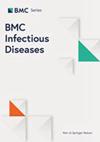摘要
背景:本研究旨在比较头孢吡肟和碳青霉烯对推定产AmpC β-内酰胺酶肠杆菌属、马氏沙雷氏菌、弗氏柠檬酸杆菌、普罗维登西亚属和摩根氏菌(ESCPM)引起的复杂性尿路感染(cUTI)的疗效:方法:在2010年至2022年期间,从中国四家医院获得了458例由不敏感头孢西丁(最小抑菌浓度(MIC)> 8 µg/mL)和敏感头孢吡肟(MIC ≤ 2 µg/mL)ESCPM引起的cUTI患者的数据,并对这些数据进行了回顾性回顾:结果:125名和333名患者分别接受了头孢吡肟和碳青霉烯类抗菌药物治疗。28天治疗失败率为15.7%(72/458)。以下因素被确定为 28 天治疗的独立预测因素:年龄、头孢吡肟 MIC = 2 µg/mL、免疫力低下状态、感染源控制、适当的经验疗法以及从发病到积极治疗的天数。在需要头孢吡肟 MIC ≤ 1 µg/mL 的患者中,多变量逻辑模型显示,在控制了这些预测因素后,头孢吡肟与碳青霉烯类相比具有相似的 28 天治疗失败风险[奇数比 (OR) 1.791,95% 置信区间 (CI) 0.600-5.350,p = 0.296]。与对头孢西丁不敏感的 ESCPM 患者相比,分离出头孢吡肟(MIC = 2 µg/mL)的患者 28 天治疗失败的风险更高(OR = 2.579,95% CI = 1.012-6.572,p = 0.047)。治疗倾向评分分析验证了这一关系:头孢吡肟和碳青霉烯类对头孢西丁不敏感 ESCPM 菌引起的 cUTI(头孢吡肟 MIC ≤ 1 µg/mL)疗效相当,而碳青霉烯类对头孢吡肟 MIC = 2 µg/mL的分离菌可能更有效。Background: This investigation aimed to compare the efficacy of cefepime and carbapenem for complicated urinary tract infection (cUTI) caused by presumptive AmpC β-lactamase-producing Enterobacter spp., Serratia marcescens, Citrobacter freundii, Providencia spp., and Morganella morganii (ESCPM).
Methods: Data of 458 individuals with cUTI caused by cefoxitin-nonsusceptible [minimum inhibitory concentration (MIC) > 8 µg/mL] and cefepime-susceptible (MIC ≤ 2 µg/mL) ESCPM was acquired from four Chinese hospitals between 2010 and 2022 and were reviewed retrospectively.
Results: 125 and 333 patients received cefepime and carbapenems, respectively, as antimicrobial therapy. The 28-day treatment failure rate was 15.7% (72/458). The following factors were identified as independent predictors for 28-day therapy: age, cefepime MIC = 2 µg/mL, immunocompromised status, infection source control, appropriate empirical therapy, and days from illness onset to active therapy. In patients who required cefepime MIC ≤ 1 µg/mL, a multivariate logistic model indicated that cefepime was linked with a similar risk of 28-day treatment failure [odd ratio (OR) 1.791, 95% confidence interval (CI) 0.600-5.350, p = 0.296] compared with carbapenems after controlling these predictors. Compared with individuals with cefoxitin-nonsusceptible ESCPM, those with isolates of cefepime (MIC = 2 µg/mL) had an enhanced risk of 28-day treatment failure (OR = 2.579, 95% CI = 1.012-6.572, p = 0.047). A propensity score for treatment analysis validated this relationship.
Conclusions: The cefepime and carbapenem had comparable efficacy for treating cUTI caused by cefoxitin-nonsusceptible ESCPM organisms with cefepime MIC ≤ 1 µg/mL, whereas carbapenems are potentially more effective for isolates with cefepime MIC = 2 µg/mL.

 求助内容:
求助内容: 应助结果提醒方式:
应助结果提醒方式:


